What does it take to scale a robotic process automation (RPA) program?
Why do so many organizations find it difficult to transition from RPA pilots to a program at scale?
Is scaling necessary if you’re just starting out with a few bots?
Due to the nature of the technology, RPA programs have the potential to ramp up quickly. A robust bot can be built in as little as a few days or weeks whereas it would have taken months to build something similar in legacy technologies. What many have failed to recognize is that these shortened development cycles make for a quick trip from your first few bots to dozens of bots that have been implemented without regard for any standards, structure, or strategy.
Leaders who don’t anticipate this growth will find themselves without the necessary capabilities to cope with a rapidly expanding RPA program; organizations will then find themselves scrambling.
Before scaling your intelligent automation program, the following areas should be considered: governance, strategy, operations, overcoming challenges, and people.
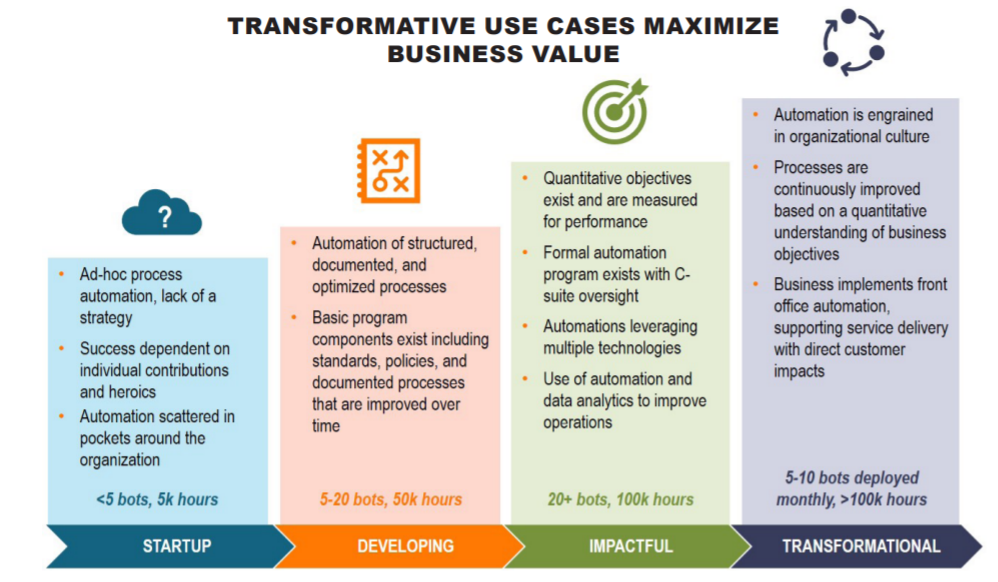
Governance
While a robotic operating center of excellence (ROC) is a good way to ensure there is a formal structure to govern your program, it is not a replacement for well-conceived governance. It is simply a formal way to manage an RPA program. Organizations tend to struggle with onerous and bureaucratic processes and policies, with too much focus on status reporting.
Although a highly regimented program might seem superior, a low-friction governance structure that balances delivery and formality, with a focus on adapting to the needs of the stakeholders, might be what your organization needs. Governance – with its balance of guidance, tools, processes, policy, and delivery – is like having guardrails that ensure your organization stays on the road to RPA success.
1. Develop a Roadmap That Includes Maturing Your Governance Tools and Processes.
As you scale, consider how tools and processes will need to evolve to adequately support the demands of a large program. These processes and tools will need to grow, adapt, and improve to support your program across the organization. You might consider implementing a use case management system that will provide structure, standard fit and value questions, and a workflow so you can maintain governance compliance and consistency. Later, you might find it important to have an automated dashboard to track bots and business value. You can easily start without a dashboard, but as demand increases while scaling your program be sure to have a roadmap for tools and governance processes to avoid falling behind.
2. Traditional Compliance Activities Still Matter.
Programs such as SOX and HIPPA will need to consider the impact of RPA. Build your governance process to take traditional business policy and regulatory compliance into account. For example, work with your internal audit team to include RPA in their broader compliance testing plans. If the cost of non-compliance is high, ensure you have the appropriate milestones and artifacts built into your Robotics Development Lifecycle (RDLC), which will ensure that bots are built without introducing new risks and that the work they perform is compliant, transparent, and can easily sustain an audit.
3. Governance May Need to Be Adapted to Work in the Larger Organization.
What works on a small scale will hit a limit as demand increases. As the program grows, set expectations with the broader organization regarding RPA developer productivity and engagement. One example of this is to have a policy allocating RPA developer licenses that look at the value and volume of bots being developed.
Another area where you may need to adapt is use case evaluation. The goal here is to ensure you see value in each proposed bot that is developed, and that all of the important considerations, milestones, artifacts, and approvals are obtained. Early on, it is fine to hold a meeting twice a month with all stakeholders to review new requests for bots. However, as the volume of bot requests grows, this can quickly become too demanding.
This is where formalizing the use case review around a defined set of criteria, and following a development lifecycle with appropriate checkpoints and milestones, will ensure that you can maintain the same level of quality and compliance you had when each use case was thoroughly reviewed by the same set of key stakeholders.
4. You Will Benefit From Having a Central Team Responsible for Developing Tools That Aid RPA.
Left alone, two creative RPA developers will create different solutions to the same need. Scale this across 20 or 200 developers, and you can see the problems that can arise from ignoring standard tools for common issues. Whatever processes you choose to automate, there will be several common tasks your bots will need to perform, recurring problems developers will encounter, and common tools process owners will need to manage their bots. Proactively planning for this need can save tremendous effort when spread across your organization.
Reusable tools will make the delivery of automation easier to achieve by providing standard solutions to the things developers and process owners need to do, which has significant benefits across governance, compliance, and risk mitigation. One example is requiring developers to manage bot credentials in a credential vault and develop an approved method for accessing them. This will provide you with an opportunity to more easily scrutinize the code to ensure there are no security vulnerabilities.
5. Iron Out Processes Prior to Scaling.
Test your processes before rolling them out to the entire organization.
The success of your program is highly dependent on people’s willingness to see the value of RPA and believe it will personally benefit them. When you roll out a program that is poorly executed or fails to take into account the basic needs of stakeholders, you run the risk of losing credibility with this important group. If the process of implementing automation is difficult, people will become disengaged, lose interest, and feel the benefits of automation are not worth the pain of getting through your governance process.
A critical component of ironing out processes is communication. Ensure you develop a communications plan letting people know what to expect, and collect feedback from them so you can make any adjustments while rolling out your program to the broader organization.
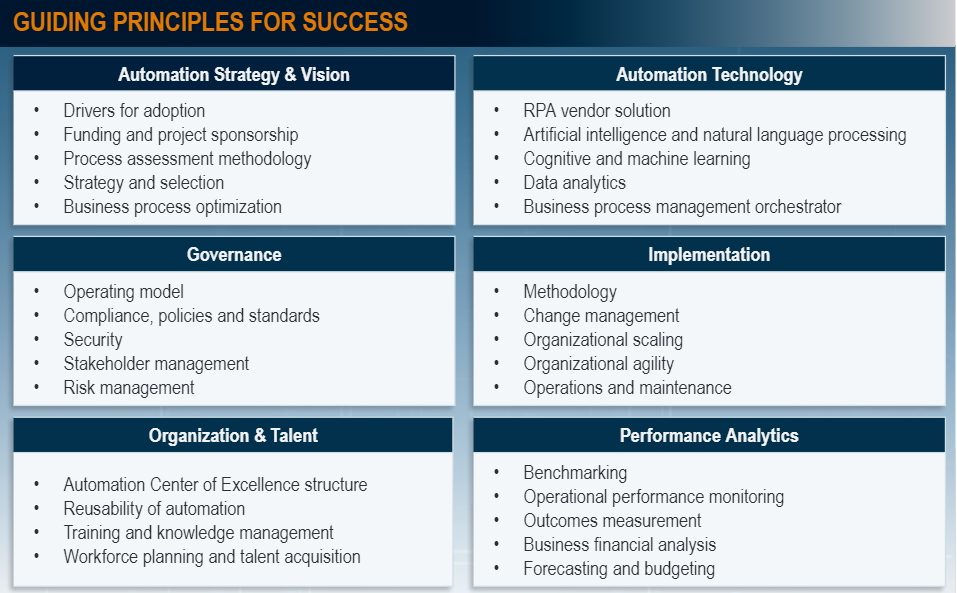
Strategy
6. Invest the Time to Develop Well-Defined Roles Catered for Robotics.
Work with stakeholders and program support staff to set clear expectations of what each role entails. RPA is a unique technology requiring a greater degree of process owner involvement. With RPA, the process owner becomes the first line of defense in monitoring bots.
We have found this commitment may require new roles that don’t currently exist within your organization. One such position is Digital Worker Controller: a supervisor of bots who is the first line of support that ensures your business process is not interrupted when the bot “calls in sick.”
7. Develop a Digital Mindset Within Your Organization.
A well-thought-out digital strategy includes a plan to cultivate the mindset of the people within your organization and help to make the transition to a digital organization.
- Recognize that implementing RPA alone won’t change the mindset of the organization. Digital transformation requires a sustained communication and education effort to help people not only see the value of RPA but believe it can improve their day-to-day work life on a very real and personal level. Helping your employees adapt their thinking to this new way of working will help them to increase their engagement and provide sustained benefits for your organization.
- Be patient. Your organization is learning how to operate in a new environment. Expect to adapt your initial strategy to match the progress of adoption within your organization. This could include implementing one set of Key Performance Indicators (KPI) focused on engagement and acceptance of RPA throughout the organization, and when the program is more mature, replacing them with more traditional ones focused on business value (i.e. dollars or hours saved).
- Acknowledge that investment in digital cannot be considered a transactional activity. An organization can capture a great ROI with RPA in a very short period. What distinguishes digital programs that lose momentum from those that see real and sustained benefits is how the people at all levels within the organization view RPA. Automation exists to elevate the user experience, customer experience, and employee engagement, not diminish them.
One way to do this is to set up guardrails for your program. Consider establishing standards for what makes a good use case, and which stakeholders should participate in their review, decision, and implementation. One example would be to allow anyone within your organization to submit automation ideas, causing people at all levels to feel empowered to help in the delivery of use cases that add real and perceived value.
8. Have a Strategy to Actively Manage Business Value.
- Use case volume and quality will trail off. Most companies can identify a list of use cases with good benefits; however, you may quickly run through your initial list. Plan for this possibility and take proactive steps to cultivate a healthy pipeline. Consider working directly with operational teams to identify an inventory of processes and quantify the opportunities beyond the siloed annoyance-type improvements. With thoughtful use case selection, you will experience great benefits and efficiencies, but getting at the processes that cut across different teams is what will truly transform your organization.
- Consider a strategy for budgeting your program. Traditional technology budgeting approaches may need to be adjusted for RPA. It is a user-centric technology, but you shouldn’t go it alone. Include IT as a stakeholder in your project from the beginning; many companies struggle when IT lacks funding to support their program. While IT may not be building the bots, they will play a role in things such as infrastructure, helpdesk, platform, and putting tools in place (i.e. a database that reinforces your bot designs). Don’t neglect the funding that IT will need just because RPA falls outside of their capital planning process. They may provide support early on but not have the funding to deliver that support at scale.
- Anticipate the closed mindset and include a strategy to address it. A closed mindset is common in established organizations and can be seen in statements such as:
- “That’s not how we do it.”
- “That won’t work, because…”
- “We tried that years ago and it didn’t work.”
- “Management will never go for that.”
Closed mindsets come from a good place – a place of experiences. It is a well-intentioned employee trying to do the right thing. RPA provides the potential to break down silos and reimagine organizational structure. Bots allow you to combine tasks that would be difficult for a single person or team to deliver because of the extensive knowledge required to complete them. You can leverage these capabilities to design a better process with the customer or employee experience in mind.
When tackling the status quo, it will be difficult to find solutions that the organization will support. It is important to remember that most people who are resistant to change may have valuable input that would result in a better solution. Consider investing in facilitated techniques such as design thinking. This is a very effective way of breaking the gridlock you will experience when trying to change how your organization operates, and avoid the emotional pitfalls that tend to upend any transformation efforts.
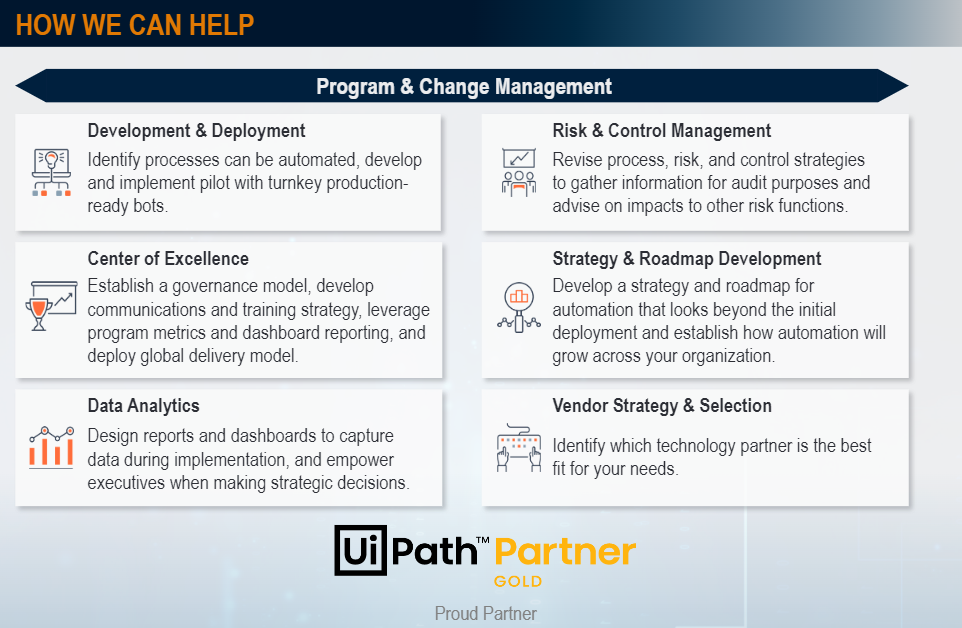
Operations
9. Embed Digital and RPA Into Your Organization in a More Significant Way.
Establish a traditional helpdesk support model for day-to-day issues with tier one support handled by the digital worker supervisor, and skilled RPA resources handling tier two and three issues.
Track reported complications and complete root cause analysis, which will provide you with valuable insight as to where you need to adapt and improve your program. Use these insights to immediately improve what you can and keep stakeholders informed about future developments to maintain the support and confidence of the teams who have embraced automation.
One effective way to gain support for proposed program modifications is to manage them like an agile team. Allow interested stakeholders to help set sprint scope and participate in the definition and implementation of any changes.
10. Managing Infrastructure Will Become a Full-Time Job.
If your program leverages any type of virtual infrastructure, be prepared to provide a high degree of support. Some focus areas include:
- Monthly software patches that overwrite machine settings needed for bots to operate smoothly in both a development and production capacity.
- Procurement support and installation to Virtual Machines (VM) for unique applications and software of different departments.
- The licensing costs of some applications will make it prohibitively expensive to buy a copy for every machine used by the developer and robots.
- You may need to adjust your machine image strategy to account for the needs of different departments. Different bots will need access to different software packages, which may make it impossible to maintain a single machine image.
- Process owners will need dedicated support when bots fail to execute time-sensitive business processes. Typical Service Level Agreements (SLA) may be insufficient to ensure business operations are not negatively impacted. Support will include keeping the machine healthy and troubleshooting bot failures that can span infrastructure, RPA platform, coding, and system access areas.
11. Active Enablement Can Make a Difference in Process Owner Perception of RPA and the Speed of Development.
At a program level, you may need to be more active in enabling automations. Establishing new roles is a good way to help process owners to be successful, such as:
- Helping process owners select use cases.
- Evaluate business value factors.
- Facilitate code reviews process design document signoff.
- Host use case reviews between IT security and process owners to facilitate effective communication between these groups.
- Troubleshoot code during development and deployment.
12. Design Processes and Tools as Simplistically as Possible.
Your stakeholders will have varying degrees of technical literacy. Delivering a successful bot to production has as much to do with technical competence as it does with understanding how to work in a project environment following a methodology that stresses good process understanding and some degree of formality. For example, an operationally literate process owner may lack the skills to meet project schedule commitments. One key area where you can help is by ensuring that they request production bot credentials early enough to address any issues before attempting to deploy the bot to production. As you develop your tools and governance processes, strive to design one that is lightweight and nimble, and that a typical end user can understand.
13. Improve Education and Engagement by Designing Policies End Users Can Understand.
When you need to use technology-centric verbiage in your policy to prevent ambiguity, provide a summary in non-technical language and a method for program stakeholders to easily obtain guidance when needed. A policy that nobody can understand is no more useful than lacking a policy and applying inconsistent guidance and enforcement.
14. Migrate From an Inward to an Outward Focus.
Rather than concentrate all of your energy on how to do things better and faster internally, consider how to leverage RPA to more adequately serve your customers. This is an important pivot to shift to a truly digital organization. Even programs operating at scale struggle to make this change. One way to measure how well you are transitioning is to calculate the number of information domains and process silos across use cases. Collect these elements as part of the use case intake and build metrics to illuminate whether they are increasing in organizational complexity.
15. Your Initial Program Structure May Need to Adapt to Work at Scale.
Operating at scale will affect your approach to licensing, staffing, support team roles, and responsibilities. Pay attention to what is working well and what is not, and then respond. Try to anticipate where you will need changes so that your initial program structure can adapt to the new demands. For example, you may learn that decentralized development is less effective than you anticipated, or you realize that you are understaffed for centralized development because more departments do not wish to build a bot development capability within their team.
Program structure and governance are not one size fits all. Each capability of your operating model comes with advantages and tradeoffs. Finding the right balance for your organization is the key to success, and to do that, don’t be reluctant to make big changes to program structure.
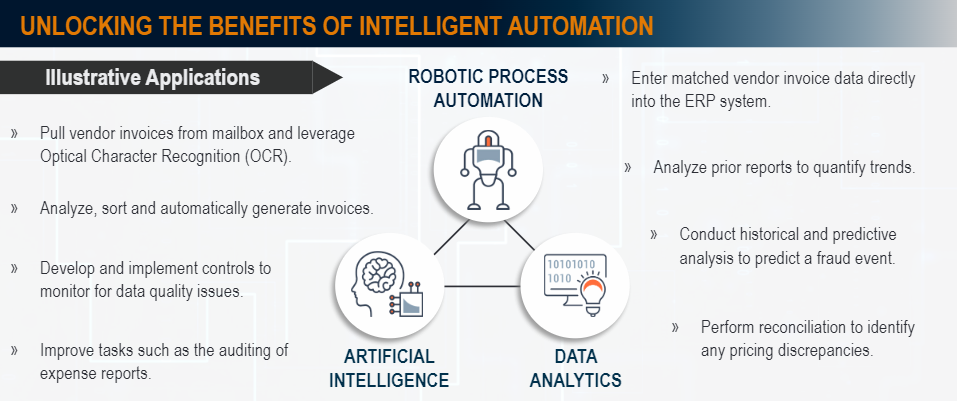
Overcoming Challenges
16. Maintaining Quality as Your Program Scales Can Be a Challenge.
As more people and departments get involved with RPA, attempting to validate the quality of everything going on in the enterprise program will not be possible. For example:
- Reviewing every use case for automation suitability.
- Code reviews to ensure the bot is not introducing risks to the production environment.
- Documentation of the designs.
This is where tools, governance, and compliance will help. The goal is to put guardrails and guidance in place that ensure people understand what is expected and cannot veer off course.
Your operating model should include specific milestones and artifacts that address important areas. This structure will drive an environment of compliance and give you the ability to pause on a bot if things such as a process area leader signs off or a code review was not completed. To do this, your operating model provides the rules of the road, the tools to help ensure people stay on the road, and the ability to easily comply with the rules. Each of these governance aspects supports each other and enhances your ability to maintain quality from afar.
17. Your Best Advocates Can Also Be Your Biggest Critics.
Early RPA users in your program will feel the growing pains. As you figure out what works for your organization, there will be friction in your processes, resistance from different internal stakeholders, and necessary changes you need to make to the processes to ensure your program satisfies company policies, expectations, and risk tolerances. Striving to provide high levels of stakeholder engagement and the most responsive experience possible for these early adopters is critical to maintaining support and confidence of the teams who have embraced automation. They are your best advocates and can also be your biggest critics when their experience with the program is subpar.
18. Hidden Problems Will Be Revealed at Scale.
As the number of bots, developers, and different departments in your program grows larger, you may observe problems you failed to see when it was small. You will start to observe issues with policies, infrastructure, procedures, governance, tools, and processes, both in how they operate and where you have gaps in your capabilities. Be prepared to adapt and reinforce anything that is lacking.
19. Process Optimization Will Create Conflict.
The promise of RPA is to transform the organization, but the temptation will be to automate processes as they are. Start by documenting the current process, but then take the opportunity to reimagine how RPA can be leveraged to work in a way not suited to people.
For example, when processing vendor invoices, have the bot track metrics on the volume, amounts, and top vendors, and then compare to trends by looking at payment history and other factors impacting your cash flow. Armed with this information and the capabilities of a bot, you could then:
- Have the bot send an email to the customer thanking them for making a payment early.
- Use the bot to periodically reward good payment behavior with a loyalty credit.
Examine the process and see where tasks and information traverse people or departments and ask why. Does the process cross domains because of specialized knowledge required for the next step, or is there intentional segregation to satisfy separation of duty requirements? Process velocity slows and creates an opportunity for error every time a business process changes hands. Because bots are not bound by the same limitations as people, consider how RPA can provide a better experience for your employees and customers.
20. Existing Manual Processes May not Be Compliant With Company Policy.
While compliance issues might be tolerated with manual processes, they may be a showstopper when applying automation to those same ones. To avoid significant delays in your bot development process, anticipate compliance gaps and incorporate checkpoints in your operating model to look for them early in the build process.
21. Execution and Delivery of Use Cases Across the Enterprise Will Be Inconsistent.
There will be a bell curve of skills and capabilities that will impact delivery execution by each team. Some teams will excel while others will struggle. Listen to your stakeholders, promote good communication, and make adjustments to the program when systemic issues are identified.
Another good practice is to provide support and enablement services to teams that have unique needs. Use case pipeline management will become an important tool to see trends in delivery. Develop KPIs focused on program velocity, publish these metrics, and use them to reach out to stakeholders who might not ask for help. While they may not tell you that they are struggling, they may be very vocal to their colleagues about how the program is lacking. Not only will the outreach be appreciated, but it may also even amplify your “digital” story throughout the organization.
Word-of-mouth organic praise can be one of the most powerful tools to build the credibility of your RPA program.
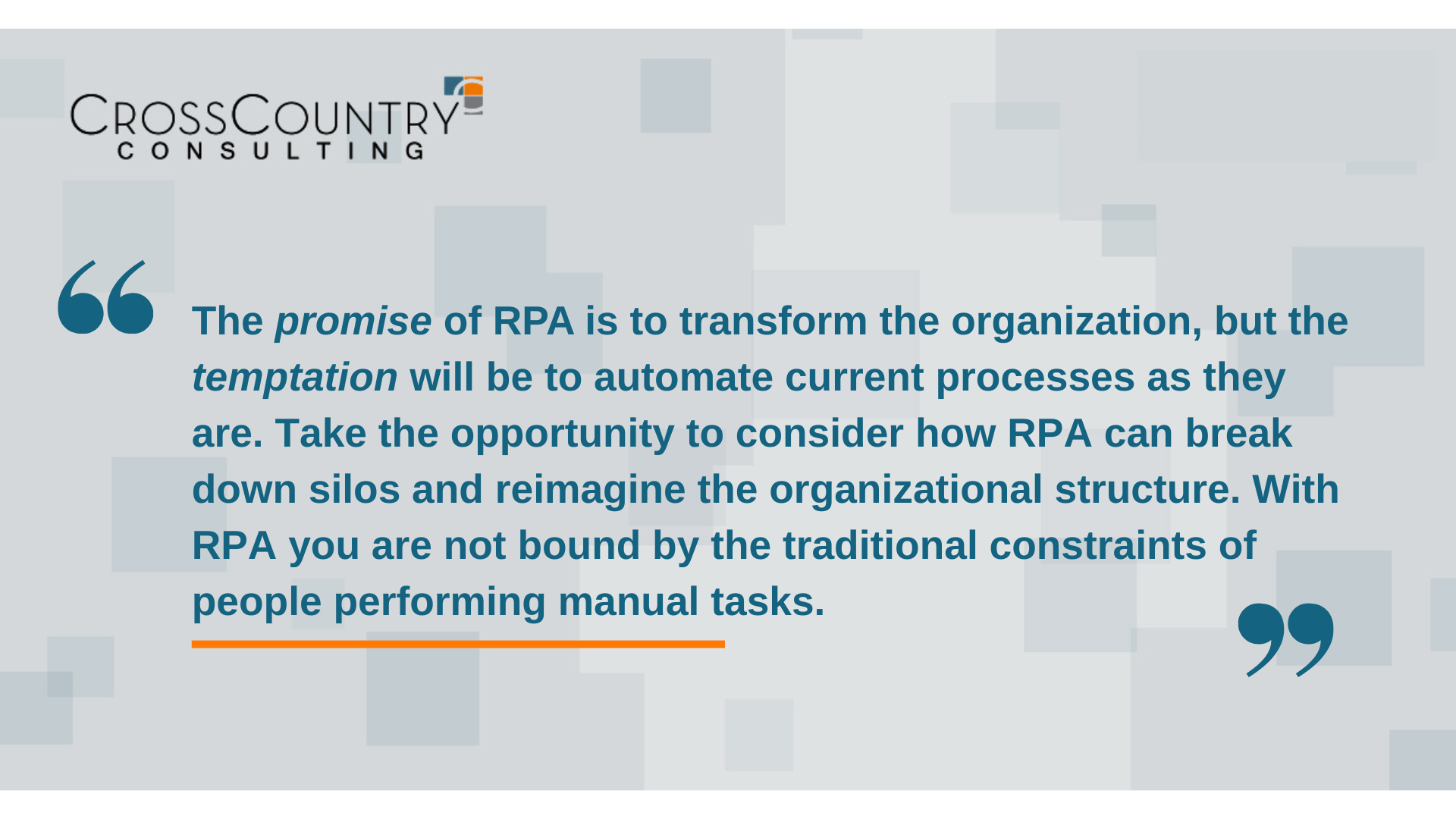 People
People
22. Invest in RPA Evangelism Throughout Your Organization.
Developing advocacy within business teams will help build trust, manage expectations, and speed adoption of RPA within your organization. Building a network of champions will ensure people are aware of the technology and can learn about it in a very organic way. Establish digital ambassadors in your ROC who can own the relationship between your program and each individual department.
Recruit people to serve as digital warriors who reside within each department to magnify your voice and ensure your message is getting out there in a consistent and sustained way. Start with an education program for the key points of contact and influencers in the teams and departments that you want to reach. Confirm they understand the basics of RPA, and show them real examples of how a bot can improve their team operations.
23. Set Clear Expectations With Your Stakeholders.
The initial excitement of RPA can wane when stakeholders realize what it takes to successfully build, implement, and manage bots. Some common misconceptions of using RPA include:
Myth: Developing bots is easy. Anyone can do it.
Reality: It takes more skill than advertised to build a robust bot for most business processes.
Myth: Bots just show up to work and don’t require much supervision.
Reality: Just like employees, bots require support and supervision to ensure that they continue working correctly.
Myth: RPA can replace people and whole jobs.
Reality: RPA automates tasks, not jobs.
Myth: If RPA saves me 40 hours a week, I can eliminate a position.
Reality: The real efficiencies are seen after RPA is implemented, more broadly enabling you to reallocate work across your employee base.
With every use case you tackle, ensure there is transparency and agreement regarding the goals of automating that process. Ideally, you should be able to tie the benefits of each use case back to one of the program goals.
One way to do this is to build criteria into your use case assessment template that evaluates automation ideas with your program goals in mind. For instance, if one of your objectives is efficiency, ensure the template includes questions dealing with the number of steps, people, departments, handoffs, and process duration. You can apply a higher weight to use cases that include many people and steps, allowing these ideas to rise to the top of your automation candidate list.
24. Adapt Your Goals to Incentivize the Behaviors You Need.
First, establish goals for your program and get buy-in from your stakeholders. Then, measure the performance of bots against these goals.
- If most of your use cases are targeting processes with a low number of manual hours, build metrics to track the median hour savings on production bots and compare that with the use cases in your pipeline.
- If the bots aren’t consistently running, resulting in the actual savings falling short of the expected savings, measure the average bot utilization of those in production.
Publish these metrics during your stakeholder meetings and on your digital dashboard to show how each department is doing relative to each other and to program goals. Your objective is to get each department to take ownership of the results and work with you to improve when they are falling behind. The digital warrior role can be pivotal in gaining this buy-in and ownership.
25. Celebrate Success.
Consider gamification strategies to incentivize the behaviors you need to drive the program forward:
- Bot birth certifications to announce the launch of new bots.
- Bot retirements to remind people of the contribution made by the automation.
- Badges for employees who complete training, received a certification, develop their first bot, or develop a top-producing bot.
26. Anticipate Resistance to Process Optimization.
The promise of RPA is to transform the organization, but the temptation will be to automate the current processes as they are. Take the opportunity to consider how RPA can break down silos and reimagine the organizational structure. Get creative; with RPA you are not bound by the traditional constraints of people performing manual tasks.
Share ideas about including value-added steps in the automated process that would not be feasible to ask an employee to do, such as taking screenshots of a journal entry posted in your general ledger and saving it as backup support. Showing how an optimized process can not only be more efficient but also include more business value is a great way to convince someone of its benefits.
27. Sustained Executive Leadership Is Important.
Senior leaders must create accountability for promoting a digital mindset at the middle management layer by:
- Highlighting digital program goals and successes such as individual or team accomplishments at all-hands meetings and in other communications.
- Building accountability around nontraditional factors that measure engagement rather than just results or returns. Consider building metrics to track the number of employees who have submitted automation ideas, the number of people in each department who have built a bot, or the number of people in each department who have completed training.
With this curated list of best practices, your next intelligent automation program can be made more strategic, more valuable, and more clear.
For expert RPA implementation support, contact CrossCountry Consulting.